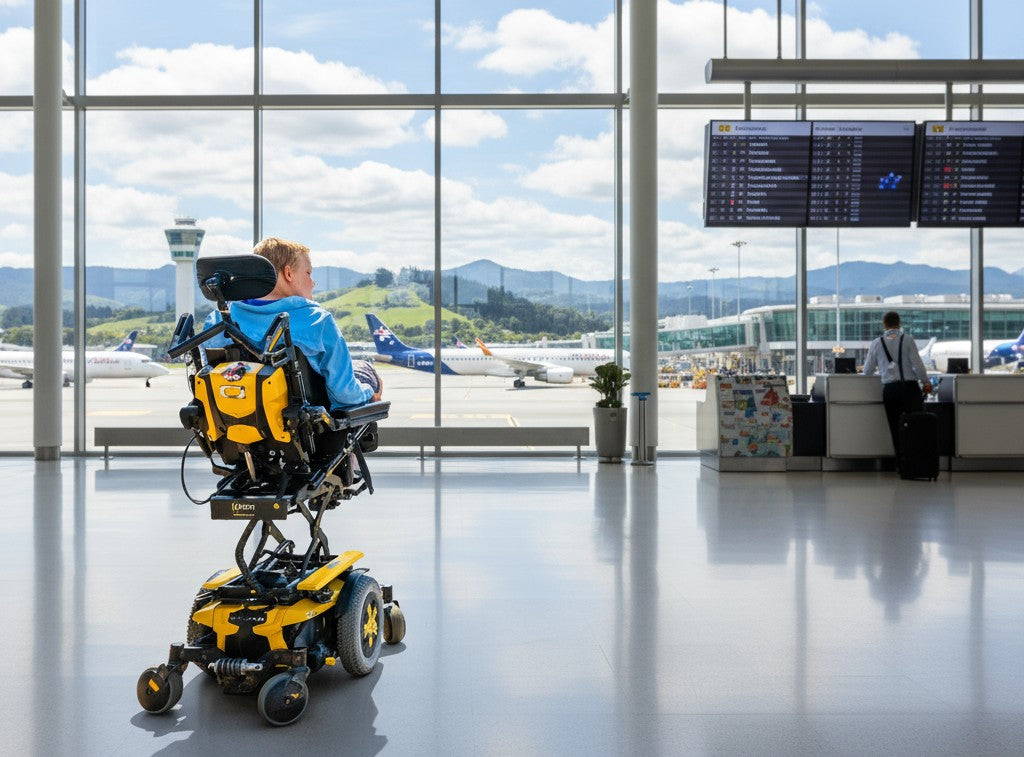For many people, travelling and getting out there, living life and enjoying all the world has to offer, is what life is about. But equally, travelling by wheelchair taxi to your doctor or to carry out daily tasks like going to the supermarket does require a little forward planning too, just like the bigger trips you sometimes may take.
When you are reliant on having your mode of mobility in good functioning order after you travel, preparing for your trip can minimise the chance of a mishap while out and about.
Here are a few tips to consider when travelling with your wheelchair, powerchair or scooter:
Before Your Trip
Plan Ahead
Contact your airline, ferry service or transport provider in advance. Provide details such as:
- Make and model of your mobility device
- Dimensions (height, width, length — with and without detachable parts)
- Weight (including batteries)
- Battery type (sealed lead acid, gel, AGM, spillable or lithium-ion)
- Battery details: if lithium-ion, provide the watt-hour (Wh) rating or, alternatively, the voltage (V) and amp-hour (Ah)
- Whether the device is collapsible
- A copy of the user manual, which explains safe handling and how to remove batteries if needed
Charge Batteries
Fully charge your batteries before leaving to avoid getting caught out during your journey. Make sure you also have your charger accessible in your luggage.
Take Photos
Document your mobility device with photos. This helps with insurance claims if damage occurs in transit.
Learn the Manual
Familiarise yourself with your device’s manual. It will help with tasks such as enabling freewheel mode or removing batteries.
Battery Safety
Battery safety is essential for travel, whether using a powerchair, scooter, or portable medical device:
- Inspect batteries for signs of swelling, corrosion, or cracks before departure
- Use only Allied Medical-approved chargers
- Do not charge batteries near flammable materials or leave them unattended overnight
- Store batteries in cool, dry, ventilated spaces and keep them secure during travel
Lithium-ion travel notes
- Lithium-ion batteries are subject to strict rules. They must often be removed for air travel and carried in your hand luggage
- Clearly label batteries with their watt-hour capacity
- Use approved travel cases for spares
- Never pack lithium batteries in checked luggage
For more, visit our Battery Safety blog.
Air Travel

Airlines have their own rules, so it is best to contact them directly well before your trip. For Air New Zealand travellers, see their Special Assistance page.
Battery regulations are set by the International Air Transport Association (IATA), and all airlines must comply. You can view the full IATA Mobility Aid Guidance here.
A few key points include:
- Spillable batteries: must always travel upright. If the device does not protect the battery, it must be removed and carried in strong, rigid packaging in the cargo compartment
- Lithium-ion batteries:
- Installed batteries can remain in the device if securely attached and protected
- Removed batteries must not exceed 300 Wh
- You may carry one spare battery up to 300 Wh, or two up to 160 Wh each, in the cabin
- All spare batteries must be protected from damage, such as in a protective pouch
Some airlines may also ask for a Material Safety Data Sheet (MSDS) for your battery. For Quantum chairs, you can find one here: MK Battery Safety Data Sheet.
Top Tips for Flying:
- Seek airline approval at least 48 hours before travel
- Fly direct where possible to reduce handling of your device
- Book a front seat to ease boarding and minimise disruptions
- Remove cushions and accessories to prevent them from detaching in transit
- Add a sign with your contact info and instructions (for example, “If you have questions, come onto the flight and ask me. Do not force the chair”)
- Speak with the ramp agent to explain handling procedures
- Remind airline staff that your chair must always travel upright — never on its side
Quantum Rehab also has a useful article on flying with an electric wheelchair.
Once You’ve Travelled
- Check your mobility device immediately and thoroughly
- Report any damage to the carrier straight away
- Request the correct documentation and procedures for filing a claim if needed
Troubleshooting
If your chair is lost or damaged, contact a local rehab provider or your funder for short-term solutions or support.
Land Transport

When travelling by car or wheelchair taxi:
- Transfer to a vehicle seat and use a compliant seatbelt system whenever possible
- Powerchairs tested to ANSI/RESNA WC19 are safest, as they include crash-tested securement points
Securement:
- Use Wheelchair Tiedown and Occupant Restraint Systems (WTORS) that meet WC18 standards
- Avoid using postural belts alone, as they aren’t crash tested
Alternative Systems:
Docking systems can also secure powerchairs and must be installed by a certified vehicle modification specialist. When in doubt, transfer out — vehicle seating and belts are always the safest way to travel.
In Summary
Travelling with your powerchair or scooter doesn’t have to be stressful. A little planning, awareness of battery safety, and clear communication with transport providers can make all the difference.
Remember:
✅ Charge and inspect your battery
✅ Know your device specs
✅ Communicate clearly with transport staff
✅ Secure your device properly
✅ Report any damage promptly
Still have questions? Our friendly team at Allied Medical is always here to help.


